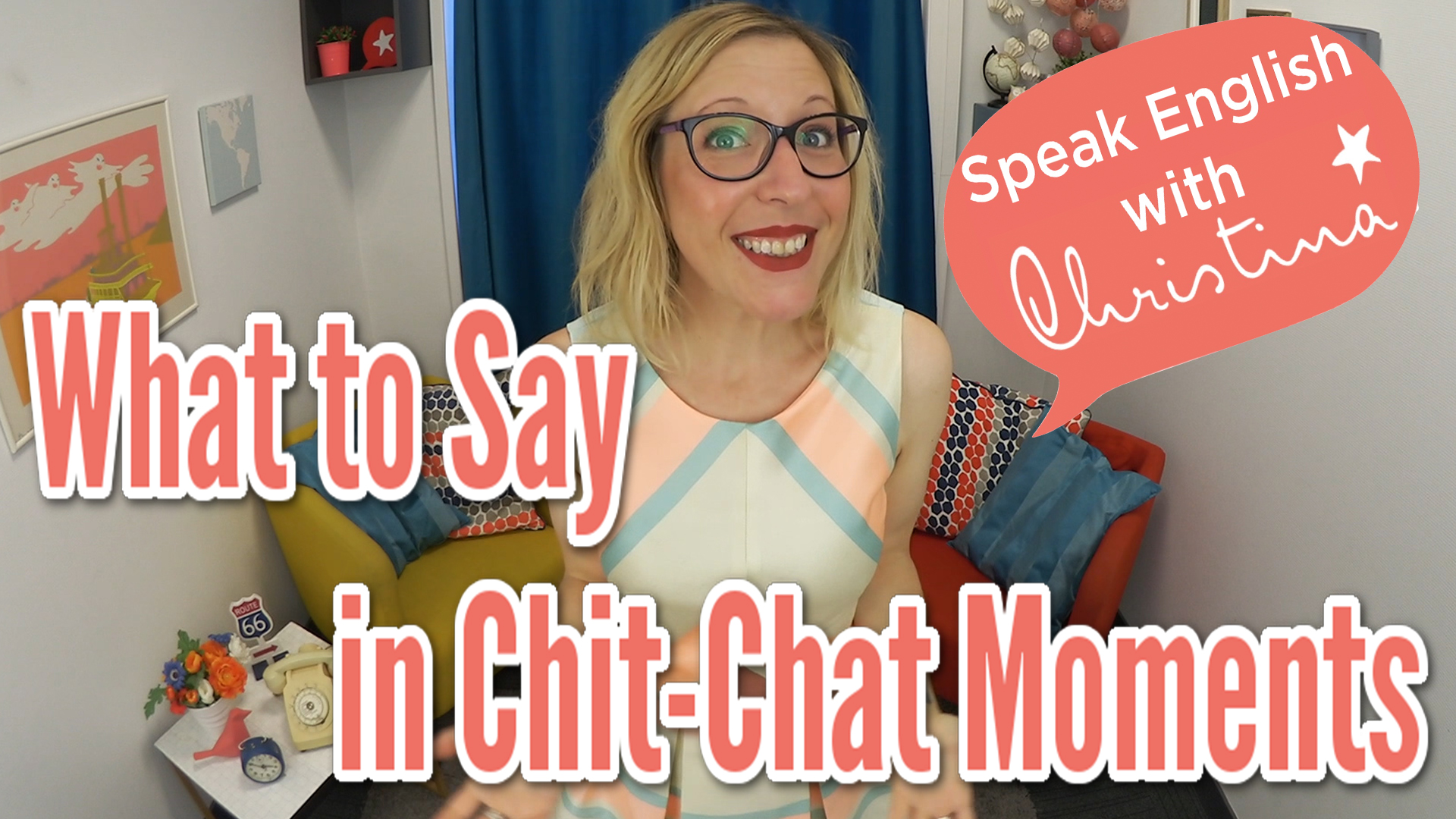
Small talk, or “chit-chat” may feel awkward, especially if you feel like you don’t have an arsenal of things you can talk about.
However, chit-chat moments are great opportunities for you to practice your American English. One of the best reasons to engage in chit-chat comes from my student Miguel.
During a Master Real American English session, Miguel said that he enjoys practicing chit-chat with English speakers because it helps him improve his pronunciation. Also, he said chit-chat introduces him to natural phrases that he can add to his own English.
Miguel is spot-on with this. And this is just another reason I want to encourage you throughout this lesson to chit-chat in English as often as you can.
And if you feel a little nervous about what you’re going to say – don’t worry. In this episode, you’re going to learn many easy, practical things that will make a big difference in how you feel about small talk. Let’s go!
So many of my students feel awkward making simple little conversations like this, but having the courage to start these little conversations as often as possible can make a huge difference in your social relationships.
That’s why I’m creating a new course to help you master social situations and everyday conversations in your professional life. It teaches you how to socialize with confidence, and build up those important personal and professional relationships, get techniques to make you a good conversationalist, as well as understand cultural differences on a deeper level.
If you want interesting conversations without feeling awkward and to make real connections in business, be sure to check that out!
It’s Just Chit-Chat
Sometimes, even native English speakers can feel nervous making small talk, or chit-chat. Keep in mind that chit-chat isn’t intended to be a deep and profound experience.
This isn’t a job interview. It’s not a marriage proposal. It’s small talk. A simple, friendly conversation.
Small talk is actually a healthy habit too, because researchers are discovering that when you make small talk, you can feel more positive and connected with others – and this positive effect can last for hours after the conversation ended.
Another good reason to make more chit-chat!
Of course, you may want to review some small talk basics, like “How to answer ‘How are you?’”, How to start a conversation in English and not be shy, and “Little words to make your conversation flow easily”.
Just knowing these basics can already give you a little confidence boost!
Find Common Ground
To get small talk started, find common ground. Common ground could be a shared experience, such as the weather, work life, school, or a networking event. It could even be something in the immediate environment, such as a movie advertisement or billboard.
For example, waiting at the bus stop gets boring. If someone else is waiting too, you could mention a Batman film advertisement you happen to see on the bus stop, as a small talk opener…You could kick-off the conversation with, “Oh, looks like the next Batman movie is coming out.”
Next, share something about yourself. It doesn’t have to be something deeply personal.
For example, continuing our Batman small talk… “I liked the special effects in the last Batman, but the story didn’t blow me away. But I did see it over Christmas weekend so maybe I wasn’t in the mood for an action flick.”
Now that you’ve found common ground and revealed something personal, it’s time to pass the ball to the other person and give them a chance to share.
Something as simple as “Have you seen that movie yet?”, of course referring to the movie on the poster at the bus stop you’re both standing at.
Be Specific
Lively chit-chat is fueled by specific questions and answers. Notice in my Batman example, I specifically mentioned the special effects, the story, and having seen it over a holiday weekend.
These specifics gives my conversation buddy opportunities to continue the conversation in a variety of ways.
They might mention a movie they enjoyed with a terrific story, or they might mention something they do with their families over a holiday weekend.
In this way, specifics provide more ways to extend the conversation rather than saying “I liked the last Batman movie”.
Awkward moment? No problem!
OK, so up until now you’ve been in chit-chat heaven. Everything has gone perfectly, and then… your chit-chat hits a moment of silence. A long lull… in English, we call it an “awkward silence.”
But guess what – I want you to use this awkward moment as another opportunity to practice your conversation skills.
If you feel awkward, chances are the person you’re talking to – or were talking to – until you hit the dreaded awkward silence– feels uncomfortable too.
Acknowledge the awkwardness and say: “Well, I guess that pretty much sums it up.” Or, “That’s a complicated subject, I’ll have to think about that one…” (If it is indeed a complicated subject).
If you’re talking about special effects in a Batman movie, there’s a better technique:
Continue the small talk by bringing up another topic, or even bring up something that was said earlier in the conversation.
For example, if your conversation buddy mentioned just buying a dog, you could follow up on that and say, “So, about the dog you mentioned earlier… Have you come up with a name?”
Or
“You said you got a dog recently? What kind of dog is it?”
Parroting and Active Listening
Parroting is a specific form of “active listening.” It can help get the other person talking more, and feel more comfortable around you.
Parroting is also a good way for English learners to clarify what someone said. Parroting may also help if you feel stuck in a conversation and not sure how to respond.
Plus it lets the other person know that you’re listening, and it feels good to be listened to. All you need to do is repeat the last few words the other person said and say it as a question.
For example, you might see a colleague carrying a big stack of papers, and you say:
YOU: “Wow, that’s a lot of paperwork. Busy day?”
THEM: “Yes, I need to get some work done before I leave for vacation.”
YOU: “Leave for vacation?”
THEM: “Yeah, I’m going to Hawaii next week. Lots of work to do before my trip!”
One important point is not to overuse this technique.
For example, it will get uncomfortable if you repeat everything your conversation partner says…
THEM: “Yeah, I’m going to Hawaii next week.”
YOU: “Hawaii?”
THEM: “Yep, for a family reunion.”
YOU: “Family reunion?”
THEM: “Yeah, and are you just repeating everything I’m saying?”
YOU: “Everything I’m saying?”
Errr….Not good.
Do a Practice Run
Many of my students enjoy chit-chat because mistakes may be easier to recover from in small talk rather than a formal meeting.
If you take this attitude, each time you engage in chit-chat you can expect a mistake or two. And that’s fine!
Instead of feeling embarrassed or ashamed, acknowledge the mistake and make a note of it, feeling grateful knowing that you likely won’t make this same mistake in a business meeting, for example.
(In this week’s episode, we have a special guest appearance by Géraldine, of Comme Une Française!)
For good small talk, you have to listen and think about what is said in the moment.
This listening means we need to be actively engaged and observant during a conversation and act on what we notice about what the other person has said.
I’ve given you techniques, such as parroting, as well as easy ways to keep a conversation flowing by asking open ended questions, getting specific, and offering up personal details.
I hope this episode has given you some ideas about small talk, so you can be more confident to start a conversation in American English with anyone you meet!
How about you?
So now, what about you? Do you have any tips or strategies about small talk in American English?
If so, please share them in the comments!
And if you’ve been a student of American English for years now and still feel awkward making small talk, check out my new course designed to help you master social situations and everyday conversations in your professional life.
Thank you for learning with Speak English with Christina, and I’ll see you next time!
More good stuff...
Click the image to learn more







